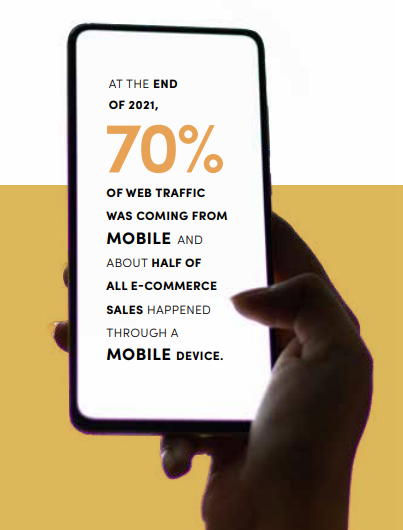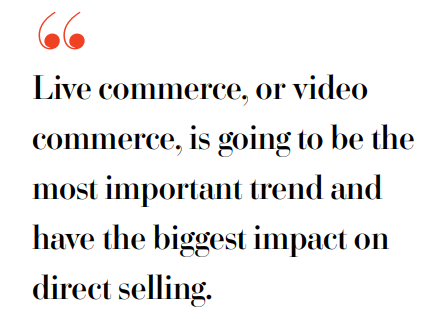The trending technologies essential for direct selling success
There is a significant and powerful evolution happening right now in the channel. Direct selling is blending with the direct-to-consumer space and it is changing two very important dynamics in the industry: The nature of our relationship with consumers and the nature of competition itself.
There are many simple and powerful platforms to choose from. Getting on an e-commerce platform should be high priority.
Traditionally, the relationship with the consumer has been managed by distributors. Companies have had limited ability to influence consumer behavior, both pre- and post-purchase, but those interactions are changing through a myriad of touchpoints across platforms and sales channels. Now, brands interact with customers every day, and we can no longer abdicate this responsibility or hand off the customer relationship. Instead, it must be owned.
Our capabilities to market and connect with consumers have increased, shifting us into the realm of direct-to-consumer, but the reverse is true as well. Direct-to-consumer brands are now realizing the power and potential of social selling, and are introducing their own commission structures and incentives for sharing their products.

While our products might not compete next to direct-to-consumer brands on store shelves, they are certainly competing in social feeds. It’s getting more difficult to cut through the clutter to win the share of mind and share of wallet that we all want.
This is driven, in part, by a change in customer behavior, but mostly, it’s being driven by technology. To succeed in this new direct selling world, we need to fully leverage and prepare for these technologies.
Consider how you can implement these digital strategies to scale an even greater relationship with customers through connection and customization.

E-Commerce
Having an effective e-commerce platform today is table stakes—it’s no longer an option. Today’s consumers are not willing to endure unnecessary friction to simply purchase a product. Our customer experience should have the same ease and convenience as every other site they purchase from on a daily basis.
Recently, I spoke to several Chief Information Officers in the channel and, by their estimates, less than 25 percent of companies in direct selling are on a modern e-commerce platform. There are many simple and powerful platforms to choose from, such as Shopify Plus, Magento, Skava and others, so, if you haven’t done so, getting on an e-commerce platform should be high priority.
Social Commerce
Prior to 2020, most of our companies were using social media platforms as part of our marketing strategies to build community. But today, most platforms are integrating purchase capability directly into their apps, so that the entire end-to-end shopping experience can happen without ever leaving the platform. This comes from awareness and product research, all the way down to product reviews and, ultimately, conversion.
While Facebook and Instagram haven’t yet integrated the ability to finalize a purchase directly on the platform, they’re working hard on it, and it’s only a matter of time before it is reality.
Video Commerce
Live commerce, or video commerce, is going to be the most important trend and have the biggest impact on direct selling, in my opinion. By 2026, it will represent ten to 20 percent of all e-commerce according to McKinsey. TikTok is leading the way through its new partnership with Shopify, with links in bio, fast checkout and integration with social payment tools.

Within the next few years, this is how I believe most of our field will market and how most of our customers will purchase.
M-Commerce
At the end of 2021, 70 percent of web traffic was coming from mobile and about half of all e-commerce sales happened through a mobile device. Not only are distributors growing and managing their businesses almost exclusively from their phone offices, but customers are increasingly engaging with our products, services, website and content through a mobile device. We need to ensure that we, as companies, have the right tools internally to enable this. Our sites must be responsive and we must have progressive web apps and mobile optimized content. We need to empower our distributor force with mobile tools, such as the NOW Technologies app, and allow distributors to onboard, communicate, sample and sell all from the convenience of their phones.
Influencer Marketing
Distributors are micro-influencers in their own right, but engaging influencer marketing at a medium or macro level can have a huge impact on generating awareness and positioning the brand. This must be intentional and targeted though, and we should establish a few key verticals or categories that our products play in that best represent the brand, and then partner with influencers and subject matter experts in those areas. Tracking these types of campaigns through tools like Tagger, Billo and Tracker will help ensure that the partnership is positioning the brand correctly over time.
Artificial Intelligence
Chatbots, product recommendations, upselling and cross-selling make a big impact, but what AI is really doing is driving a more personalized digital shopping experience.

In this vein, companies need to determine their best approach to managing a customer’s experience on Amazon. Amazon is now the second-largest search engine and it’s often the buyer’s first stop. It has an enormous impact on the brand experience and we have to engage with it. Inconsistent brand messaging in regard to multiple price points, varying product quality and a poorly managed Amazon experience can make a brand a mess. This experience should be owned by the company to firmly anchor a retail price point, position the brand properly, enhance positive reviews and ultimately ensure that customers have a positive overall experience.
Immersive Commerce
Many brands are creating cool and unique shopping experiences through virtual reality and augmented reality. This may look like walking through virtual stores to experience products, or, like Young Living has done, allowing customers to visit the company farm. While the full potential of these technologies is still yet to be realized, there is plenty of potential for new ways that customers can experience a brand in exciting, cutting-edge ways.
Performance Marketing
In today’s world, we have to pay for results, whether those results are traffic, views, leads or sales. Unpaid posts are no longer getting the reach and engagement they once were, and performance marketing is now imperative.
To accommodate this change, marketing departments need to be organized somewhat differently as well. We still need a dynamic and capable field marketing team and we need a performance marketing team that is digitally driven. These teams may have vastly different skill sets, but they need a shared mindset that supports distributors’ sales efforts and provides value to customers.
Marketing Automation
Tools like HubSpot and Marketo can streamline and simplify some of the most time consuming and potentially repetitive marketing tasks by sending out automated messages to distributors and customers based on their behaviors. Automating these actions nurtures relationships and helps move customers and distributors further down their paths.
Play to Your Strengths
It’s important to remember that all of these trending automations are not in conflict with distributor efforts. In fact, these tools and strategies enable us to partner even more closely to build the brand and drive additional sales volume within their organizations.
This is such an exciting time to be part of direct selling. We understand social selling better than any other channel, and we know how to truly bring personalization to purchasing. With these technologies, we can continue to do what we do best, but at an even greater scale.
WAYNE MOOREHEAD has deep experience in marketing and brand strategy. He has applied his expertise and passion to help companies (from startups to Fortune 100) define, communicate and activate their brands. Wayne’s rare blend of experience and success has shaped his philosophy on effective growth strategies, and he believes the future of the channel will blend the best of direct selling with the best of direct-to-consumer.
From the January 2022 issue of Direct Selling News magazine.


